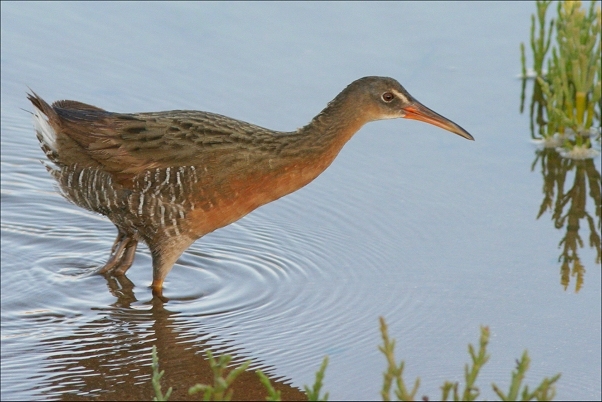
Date: 2005-06-30
Lens: Canon 300mm IS F4

 Clapper Rail
Rallus longirostris
Clapper Rail
Rallus longirostris
 Description
Description
There are over 20 subspecies of Clapper Rail found along the coasts of North, Central, and South America. California has three subspecies, the California Clapper Rail, found primarily around San Francisco, the Light-footed Clapper Rail, found along the coast of southern and Baja California, and the Yuma Clapper Rail, found along the lower Colorado River and Salton Sea.
The North American western subspecies of the Clapper Rail are on the U.S. Endangered Species List. The Light-footed Clapper Rail is the subspecies found in southern California and has been on the list since the early 1970's.
This secretive bird is often best seen during high tides, when the bird is forced out of the thick marsh vegetation. Preferring to run, the bird rarely flies. They are opportunistic feeders, but prefer crabs and crayfish.
Light-footed Adult (R.l.levipes): Gray-brown cap, cheeks, hindneck, back, and upperwings. Brownish back and wing coverts are edged with gray. Cinnamon or rust-colored breast. Whitish throat. White and dark brown barred flanks. Long, slightly downcurved bill. Short tail, which is often held erect. Sexes similar. 14 to 16 inches in length.
California Adult (R.l.obsoletus): Similar to Light-footed Clapper Rail.
Yuma Clapper Rail (R.l.yumanensis): Similar to Light-footed Clapper Rail.
Gulf Coast Clapper Rail (R.l.scottii): Similar to Light-footed and Yuma Clapper Rails, except has gray cheeks and paler rusty-cinnamon breast.
Atlantic Coast adult (R.l.crepitans): Similar to Light-footed Clapper Rail, except has gray cheeks, buffy breast, whitish throat and belly, and its flanks are barred with white and gray-brown.
Salt and freshwater marshes.
 Nesting
Nesting4-12 buff eggs with brown spots or blotches. The eggs have a 18-27 day incubation period. Fledging occurs in 1-2 days. The nest, which is often domed, is a shallow or deep bowl made of dry, hollow, buoyant, marsh grasses, which allow the nest to float up and down with the rising and falling tides.